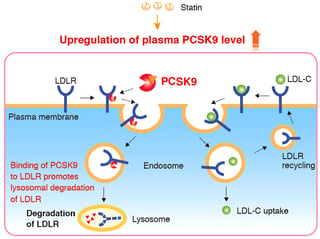PCSK9
 PCSK9 (neural apoptosis-regulated convertase, NARC-1) is a 692-residue extracellular11`q protein expressed primarily in the kidneys, liver and intestines. PCSK9 has a major role in cholesterol metabolism through post-translational down regulation of LDLR, the receptor responsible for clearing LDL-C from plasma. The secreted form of PCSK9 binds to LDLR directly and results in degradation of the receptor.
PCSK9 (neural apoptosis-regulated convertase, NARC-1) is a 692-residue extracellular11`q protein expressed primarily in the kidneys, liver and intestines. PCSK9 has a major role in cholesterol metabolism through post-translational down regulation of LDLR, the receptor responsible for clearing LDL-C from plasma. The secreted form of PCSK9 binds to LDLR directly and results in degradation of the receptor.
PCSK9 inhibition has been shown to effectively lower plasma LDL-cholesterol. This strategy is able to enhance the LDL-cholesterol lowering ability of statins in patients with severe hypercholesterolemia who are intolerant of statins. MBL International has been leading the way in providing PCSK9 assay kits and reagents for the goal of progressing PCSK9 clinical trials.
Related Products
Learn more about the most popular Metabolic/Inflammatory targets and products
Chitinase
Chitin is a β1–> 4-bonded biopolymer of N-acyl-D-glucosamine, and is the main component of exoskeletons and cell walls of various organisms including arthropods, nematodes, and fungi. However, it has not been found in vertebrates.
Glycated Proteins/AGEs
Reducing sugars react with protein amino groups to form a diverse group of protein-bound moieties with fluorescent and cross-linking properties.
S100 Protein Family
S100 protein family of calcium binding proteins with 2 distinct helix-loop-helix motifs (EF-hands) shows cell typespecific expression and consists of 20 members.
Adipokine/Lipid Metabolism
A reduction in adiponectin serum levels is accompanied by insulin resistance states, such as obesity and type 2 diabetes mellitus.
Inflammation
Thioredoxin-interacting protein (TXNIP), the endogenous inhibitor of thioredoxin also known as vitamin D3 up-regulated protein-1 or thioredoxin-binding protein-2, inhibits thioredoxin antioxidative function by binding to its active-site thiols.
Other Markers
Lactoferrin is an iron-binding glycoprotein of the transferrin family that is expressed in most biologic fluids, such as the breast milk, particularly the colostrums, tears, sweat, saliva and other exocrine secretions of mammals.